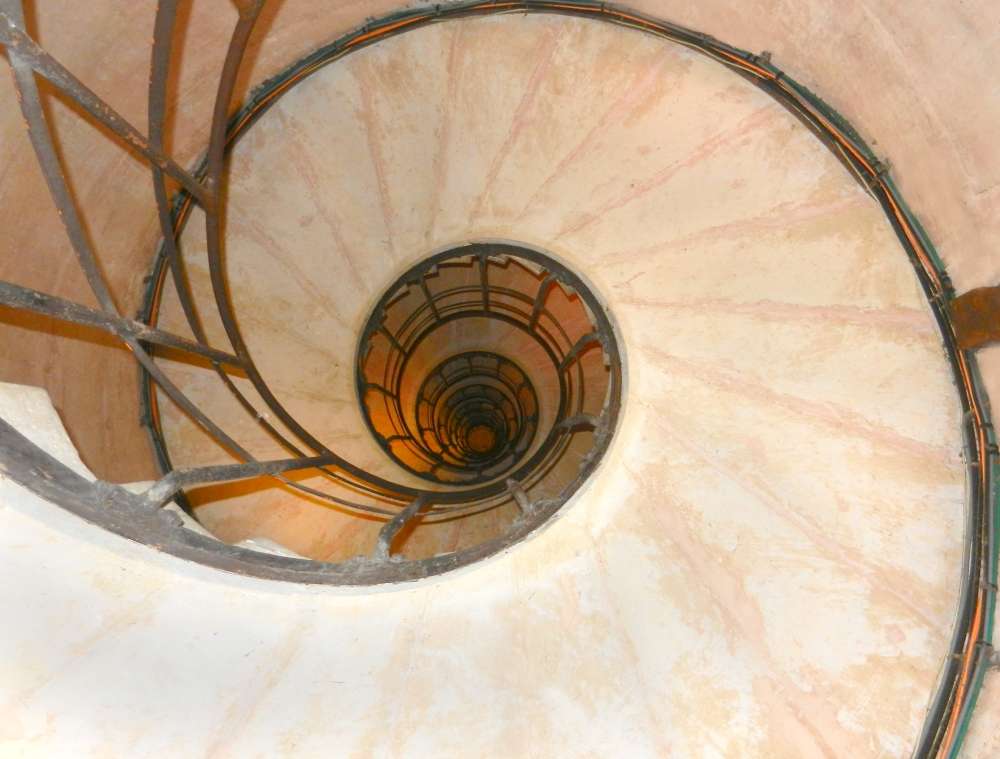Since we ended up taking the TGV after our flight from Nice cancelled the night before, it was noon by the time we checked into our Paris hotel. We were forced to cancel a morning tour and decided to focus the rest of the day on 2 of the most iconic sights in Paris: the Arc de Triomphe and Tour Eiffel (Eiffel Tower).
The plan was to visit the Arc the Triomphe at Place de l’Etoile for panoramic views in the afternoon and then head over to Tour Eiffel just before sunset to capture the dusk and night views from the Tower.

Standing beneath the vaults of the Arc de Triomphe, one feels the monument’s heroic scale – in fact, French pilot Charles Godefroy flew a biplane through it in 1919 as a stunt!
I had hoped to see the lighting of the eternal flame at the Tomb of the Unknown Soldier by the base of the Arc, but the Eiffel Tower won out, so maybe next time…

Since I consider hiking up stairs to tops of cathedrals and monuments a fun way to exercise, this is perfectly fine with me – just need to allow extra time for going ‘bumper to bumper’ with other folks up the equivalent of 16 stories!

La Grande Arch is the visual anchor of the massive la Défense, France’s Manhattan on steroids and home to many of Europe’s tallest high rises. This is also the terminus of the monument-studded Axe historique (Historical Axis), a grand boulevard that began at the Louvre and coursed through the Arc de Triomphe over a stretch of 10 km.

We had to be in line by 5 pm to make sure we were up the Eiffel Tower before sunset. Luckily, it was off season and it’s always a shorter wait for anyone willing to use the stairs.

For a few moments, the iron base in ‘Eiffel Tower Brown’ glowed red in the waning sun. It was an amazing sight!

A series of bridges criss-cross the the Seine while the tourist ‘bateaux’ cling to both sides of her banks, ever ready to ply the river with their selfie-besotted cargo day or night.

I reluctantly decided against taking the elevator to the top of the tower. While it will be a great view of the City of Lights (literally), we would be too high up to discern anything. Instead, I dashed up and down the stairs taking random pictures as the high pressure sodium spotlights turned the Tower’s infrastructure into a golden tracery against the velvet sky.

The next morning dawned bright and clear, an auspicious start for our day trip to the pleasure palace of the Bourbon kings. We learnt the hard wat that some trains don’t stop at Versailles, but quickly got into full swing as we entered the massive grounds of the château. We wandered into the Marble Court as we tried to find the entrance into the main building.

The Royal Chapel was built in honor of Saint Louis, the patron saint of the Bourbons. The second floor was reserved for the royal family while the ground floor was for members of the court and the public.

I looked around the Palace for the Galerie des Glaces (Hall of Mirrors) with great anticipation. I had studied it in my interior design class but nothing beats seeing the real thing – even if it were in between a tsunami of tourists every few minutes! The massive room is designed with 17 sets of arches along its length – windows on one side looks onto the gardens while the other side is mirror-covered to amplify the exterior views. The rows of chandeliers certainly add pizzaz and opulence to the room!

The Grand Trianon, with its own park on the grounds of Versailles, was originally built for the mistress of Louis XIV. It was subsequently commandeered as residence for the ‘royals’ and even Napoleon & his empress spent time there. It’s now used as one of the presidential residences to host foreign officials.

The Grand Trianon was one of Napoleon’s residences, as evidenced by the Empire furnishings throughout the palace. Empress Marie Louise of Austria used part of this large room as a sitting area alongside her sleeping alcove. A scant railing separated her from the courtiers 24/7.

Situated between the round vestibule and the dining room, this salon has windows on 2 opposite ends, making it one of the sunnier spots in the palace.

This elongated space was created out of 2 rooms by Louis-Philippe to help him spend time with his family. There are tables with drawers to hold needlework or games, and an abundance of upholstered seating to accommodate the crowd. The bright blue and yellow fabric covering the walls and sofas gives the salon a cheery, relaxed look.

The malachite was a gift from Tsar Alexander I to Napoleon, who made excellent use of the stone to decorate his State Drawing Room.

The mondo ozukuri display was sponsored by the Japanese to commemorate the 90th anniversary of cultural partnership between Japan and France. The chrysanthemum is the insignia of the imperial family and also symbolizes joy and longevity in Japan.


